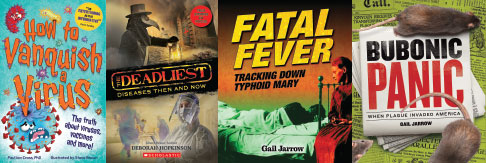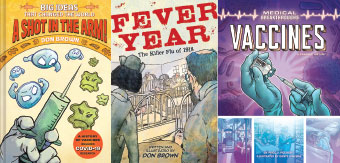16 Middle Grade Titles on Germs, Vaccines, and Pandemics
Now is the time—while the world strives to emerge from a devastating global pandemic—to meet middle grade readers wherever they are in their educational journey at a history-making moment.
Now is the time—while the world strives to emerge from a devastating global pandemic—to provide middle grade readers with the knowledge they need to understand the history-making moment they are living through. The books listed here will help meet young readers wherever they are in their educational journey.

Upper Elementary to Middle School
CROSS, Paul Ian. How to Vanquish a Virus: The Weird World of Viruses...Explained! illus. by Steve Brown. Welbeck. 2021. Tr $9.95. ISBN 9781783127313.
Gr 4-8–Readers cover a lot of territory with this informative yet reassuring look at viruses—from what a virus is to how it functions. It also provides a more in-depth look at coronaviruses: MERS, SARS, the common cold, and COVID-19. Included is information about how our immune system works, a brief history of vaccine science (including information on the COVID-19 vaccine), and warnings about the dangers of misinformation. Chapters end with a suggested activity, such as creating a face covering.
HOPKINSON, Deborah. The Deadliest Diseases, Then and Now. Scholastic Focus. 2021. Tr $25.99; pap. $7.99. ISBN 9781338360226.
Gr 4-8–Put this in the hands of “I Survived” series enthusiasts. Drawing on historical accounts of plague chroniclers and scientific research, Hopkinson describes what life was like during the three waves of the bubonic plague. She draws parallels between plagues of the past such as the 14th-century Black Death and the current COVID-19 pandemic caused by the SARS-Co-2 virus. Appealing ink drawings illustrate text.
 JARROW, Gail. Bubonic Panic: When Plague Invaded America. Calkins Creek. 2016. Tr $18.95. ISBN 9781620917381.
JARROW, Gail. Bubonic Panic: When Plague Invaded America. Calkins Creek. 2016. Tr $18.95. ISBN 9781620917381.
Gr 5-8–Plague arrived in San Francisco in 1900 and claimed its first victim in Chinatown. The area was quickly quarantined by the Board of Health, but with California Governor Henry T. Gage denying the existence of plague and Chinese officials bucking against apparent discrimination, tensions rose, and containment efforts initially failed. Abetted by numerous photographs and newspaper clippings, as well as compelling writing, Jarrow tells the fascinating story of the bubonic plague in America.
 JARROW, Gail. Fatal Fever: Tracking Down Typhoid Mary. Calkins Creek. 2021. pap. $11.99. ISBN 9781635925159.
JARROW, Gail. Fatal Fever: Tracking Down Typhoid Mary. Calkins Creek. 2021. pap. $11.99. ISBN 9781635925159.
Gr 5-8–In 1900, typhoid sickened 400,000 Americans, causing 35,000 deaths. Mary Mallon, a “silent carrier” of typhoid, was responsible for numerous deaths before she was forcibly quarantined. Mary’s story is intertwined with that of two others working to contain the disease: George Soper, a sanitation engineer, and Josephine Baker, a Department of Health doctor. A chapter on COVID-19 and how it relates to infectious diseases of the past is included in the 2021 reprint.
KAY, Edward. Germy Science: The Sick Truth About Getting Sick (and Staying Healthy). illus. by Mike Shiell. Kids Can. 2021. Tr $18.99. ISBN 9781525304125.
Gr 4-8–Germs are tiny and everywhere, including all over our bodies! What are germs, how do they make us ill, and how can we protect ourselves? Kay explains all of this and more. Illustrations are clever, colorful, and humorously match the spirited text. Most interesting is the future of germ research; scientists are working on new uses, such as employing bacteria to make fuel cells and new types of plastics.
MESSNER, Kate. History Smashers: Plagues and Pandemics. illus. by Falynn Koch. Random. 2021. Tr $12.99. ISBN 978 0593120415; pap. $7.99. ISBN 978059 3120408.
Gr 3-7–Learn the unvarnished, and sometimes unexpected, truth about plagues and pandemics throughout history. The bubonic plague, yellow fever, cholera, typhoid, smallpox, tuberculosis, polio, AIDS, Ebola, and COVID-19—it’s all here. Chatty text is complemented by sidebars, photographs, illustrations, and comic book inserts. Surprising tidbits of information engage readers (e.g., plague-infected fleas vomit stomach contents into victims after biting them).
SISTERÉ, Mariona Tolosa & Ellas Educan Collective. The Secret Life of Viruses: Incredible Science Facts About Germs, Vaccines, and What You Can Do to Stay Healthy. Sourcebooks Explore. 2021. Tr $17.99. ISBN 9781728239767.
Gr 3-5–Colorful and vibrant illustrations bring this overview of viruses to life. The illuminating spreads address distinct topics, such as what a virus is and how our immune system protects us from dangerous viruses. Also included is a catalogue of viruses throughout history and a very brief time line of a few key events in virology history. Readers will enjoy the true or false quiz at the end.

Middle School to High School
 BAUSAM, Ann. VIRAL: The Fight Against AIDS in America. Viking. 2019. Tr $22.99. ISBN 9780425287200.
BAUSAM, Ann. VIRAL: The Fight Against AIDS in America. Viking. 2019. Tr $22.99. ISBN 9780425287200.
Gr 8 Up–A recounting of the AIDS epidemic through a sociological lens. Chapters cover a few years at a time, beginning with the late 1960s and taking readers up to the present day. The bleakest years, 1981-1996, are covered extensively and recount in detail the struggles and activism of the gay community and their allies. An unflinching examination of a modern-day plague that didn’t have to be as deadly as it was had the government taken timely action.
GOLDSMITH, Connie. Understanding Coronaviruses: SARS, MERS, and the COVID-19 Pandemic. Twenty-First Century. 2021. Tr $37.32. ISBN 9781728428888.
Gr 7 Up–A well-researched summary of the COVID-19 pandemic. Goldsmith explains the disease’s likely origins, provides an overview of epidemics and pandemics throughout history, and elucidates the difference between various coronaviruses. Political partisanship in the U.S. in response to science recommendations and preventative measures, the disproportionate impact COVID-19 has had on people of color, the spike in anti-Asian hate incidents, plus the enormous effort to create vaccines (and the complicated roll-out effort) are also covered.
HAELLE, Tara. Vaccination Investigation: The History and Science of Vaccines. Twenty-First Century. 2018. Tr $37.32. ISBN 9781512425307.
Gr 7 Up–Counter the current anti-vaccination climate with this informative resource. Haelle describes how vaccines work and how they are created. Particularly interesting is the history of vaccine resistance. Despite the overwhelming evidence that vaccines are beneficial, individuals have resisted vaccination efforts beginning with Britain’s 19th-century mandatory vaccine laws, instituted to combat smallpox. Published prior to the COVID-19 vaccine.
 MARRIN, Albert. Very, Very, Very Dreadful: The Influenza Pandemic of 1918. Knopf. 2018. Tr $21.99. ISBN 9781101931462.
MARRIN, Albert. Very, Very, Very Dreadful: The Influenza Pandemic of 1918. Knopf. 2018. Tr $21.99. ISBN 9781101931462.
Gr 6–During the three waves of the 1918 influenza epidemic, over 500 million people around the world contracted the disease, and an estimated 50–100 million people died. Marrin explains how the disease likely originated and quickly spread. Troops involved in World War I, confined in close quarters and traveling far and wide, ensured that no corner of the globe was spared. A gripping, mind-boggling account.
MURPHY, Jim & Alison Blank. Invincible Microbe: Tuberculosis and the Never-Ending Search for a Cure. Clarion. 2015. pap. $11.99. ISBN 9780544455948.
Gr 6 Up–This is the fascinating story of tuberculosis, a disease that is responsible for the most deaths in the history of the world. The earliest evidence of the disease was found in the fossilized skull of a 500,000-year-old male homo erectus. Murphy and Blank follow the trajectory of the disease over time, examining efforts to treat, cure, and prevent its spread. They also explore how race and class factored into the treatment of victims.
PETERS, Marilee. Patient Zero. Annick. 2021. Tr $24.99. ISBN 9781773215167; pap. $14.95. ISBN 9781773215150.
Gr 6 Up–Epidemiologists are disease detectives who research how an outbreak starts to contain the spread. With text that reads like a thriller, this volume takes readers along as epidemiologists explore eight deadly diseases in the search for “patient zero,” the first person infected. Research begins with the bubonic plague in 1665 London and continues with chapters that cover yellow fever, typhoid, influenza, Ebola, and AIDS; a new chapter on COVID-19 is included in the 2021 reprint.

Graphic Nonfiction
 BROWN, Don. A Shot in the Arm! illus. by Don Brown. Abrams. 2021. Tr $13.99. ISBN 9781419750014.
BROWN, Don. A Shot in the Arm! illus. by Don Brown. Abrams. 2021. Tr $13.99. ISBN 9781419750014.
Gr 4-8–Smallpox has wreaked havoc throughout history, explains Lady Mary Wortley Montagu, an 18th-century writer, in this graphic novel. Scarred by the disease herself, Montagu was instrumental in bringing the knowledge of inoculation, common in the Ottoman Empire, to England. Montagu narrates the story of vaccinations, touching on key discoveries, right up to research on COVID-19. Information on COVID-19 vaccines isn’t included, as this was published just prior to discovery.
BROWN, Don. Fever Year: The Killer Flu of 1918. illus. by Don Brown. Clarion. 2019. Tr $18.99. ISBN 9780544837409.
Gr 6 Up–With haunting drawings, at times sketchlike and ephemeral, Brown captures the panic, confusion, and utter despair that the influenza of 1918 left in its wake as it spread across the globe, killing millions during the waning days of the first world war. Brown focuses on the nurses, doctors, and scientists who toiled away to aid the sick, determine the cause, and prevent further outbreaks.
POLINSKY, Paige V. Vaccines: A Graphic History. illus. by Dante Ginevra. Graphic Universe. Tr $29.32. ISBN 9781541583900; pap. $9.99. ISBN 9781728448725.
Gr 4-7–Polinsky cuts right to the chase and explains to readers how vaccines work to boost the body’s immune system and the vital importance of vaccines in global health. She then backtracks and explains how vaccines developed, beginning with the smallpox vaccine. Attention is paid to the development of other vaccines for diseases such as rabies, pertussis, measles, polio, Ebola, and COVID-19. Super readable and informative, with graphic panels that capably complement the text.

Ragan O’Malley is head librarian at St. Ann’s School, an independent school in Brooklyn, NY.
RELATED
The job outlook in 2030: Librarians will be in demand
The job outlook in 2030: Librarians will be in demand
ALREADY A SUBSCRIBER? LOG IN
We are currently offering this content for free. Sign up now to activate your personal profile, where you can save articles for future viewing






Add Comment :-
Be the first reader to comment.
Comment Policy:
Comment should not be empty !!!